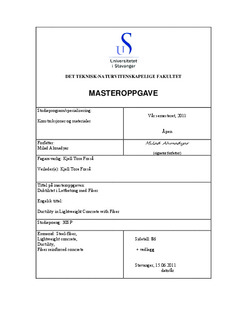| dc.contributor.author | Ahmadyar, Milad | |
| dc.date.accessioned | 2011-10-24T16:32:32Z | |
| dc.date.available | 2011-10-24T16:32:32Z | |
| dc.date.issued | 2011 | |
| dc.identifier.uri | http://hdl.handle.net/11250/182794 | |
| dc.description | Master's thesis in Structural engineering | en_US |
| dc.description.abstract | This master thesis presents the influence of different fiber in high-performance lightweight concrete
and the ductility capacity of reinforced lightweight concrete beam. Twelve beams with length of 2.2m
and reinforcement ratio 0.24 have been tested under 4 point bending, three of them were made by
normal density aggregates as references beams. The target concrete compressive strength for all beams
were 50MPa.
Three different types of fibers such as steel fiber, Polypropylene macrofiber and Polypropylene
microfiber (PP-fiber)with two different fraction volume has been used to study the influence of fibers
on high-performance concrete.
Two types end-hooked steel fibers with a length/diameter 50mm/1mm (N50) and 35mm/0.55mm (N35)
has been evaluated. The behavior of plastic-fiber with a length/diameter 50mm/1mm and
Polypropylene fiber with length/diameter 12mm/0.22mm have been also investigated. Steel-fibers and
plastic-fiber were studied by two volume fraction 1 and 2%. The volume fraction of PP-fibers were
decided to be 0.4 and 0.6% because of low volume density.
Test results showed that use of plastic-fiber and PP-fiber has no influence on crack-width development.
Beams with plastic-fiber showed the same crack-width comparing to concrete beams without fibers.
PP-fiber give negative results specially by increasing the volume fraction from 0.4% to 0.6%. Endhooked
steel fibers decreased the crack opening under loading compering to references beams. Test
result showed that use of N50 in a volume fraction greater than 1% will decrease the crack-width at
beam under same loading conditions comparing to beam with 1% volume fraction.
All beams failed due flexural failure under loading. The lightweight concrete showed brittle failure and
sudden fracture. Beams with end-hooked steel fibers had a ductile behavior during failure, increasing in
volume fraction of steel fiber from 1 to 2% increased the flexural moment capacity of beam under
loading. Both type of steel-fiber with a 1 and 2% volume fraction showed the highest increasing in
ductility and moment capacity during loading to failure.
Plastic-fiber resulted in to increasing ductility of beams, volume fraction greater than 1% had better
influence on beam ductility and moment capacity of beam. The plastic-fiber beam with volume
fraction 2% failed at the same load as normal density concrete beam but with higher ductility capacity. PP-fiber with higher volume fraction than 0.4% caused segregation by swallow cement pasta, and
caused bleeding by releasing the water after casting of concrete. Bleeding and segregation caused low
concrete compressive strength and low moment capacity for beam during loading. | en_US |
| dc.language.iso | eng | en_US |
| dc.publisher | University of Stavanger, Norway | en_US |
| dc.relation.ispartofseries | Masteroppgave/UIS-TN-IKM/2011; | |
| dc.subject | steel-fiber | en_US |
| dc.subject | lightweight concrete | en_US |
| dc.subject | ductility | en_US |
| dc.subject | fiber reinforced concrete | en_US |
| dc.subject | materialteknologi | en_US |
| dc.subject | byggkonstruksjoner | en_US |
| dc.title | Ductility in lightweight concrete with fiber | en_US |
| dc.type | Master thesis | en_US |
| dc.subject.nsi | VDP::Technology: 500::Materials science and engineering: 520 | en_US |
